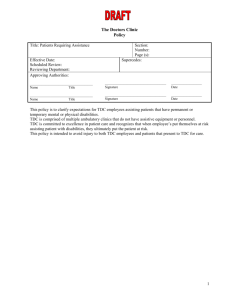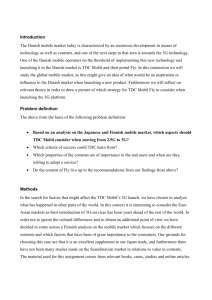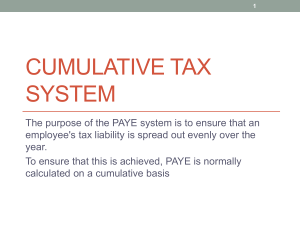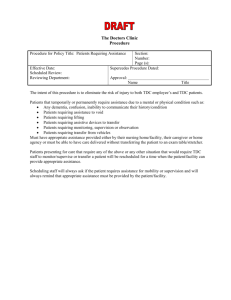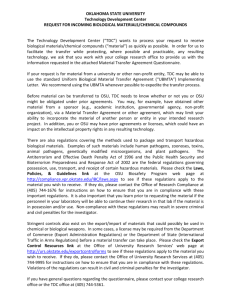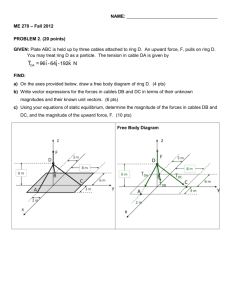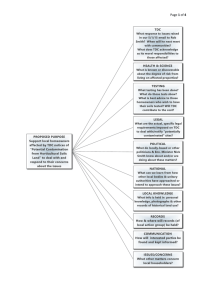James Yu's Intro to LAN and OSI Model slides from TDC 363 Winter
advertisement
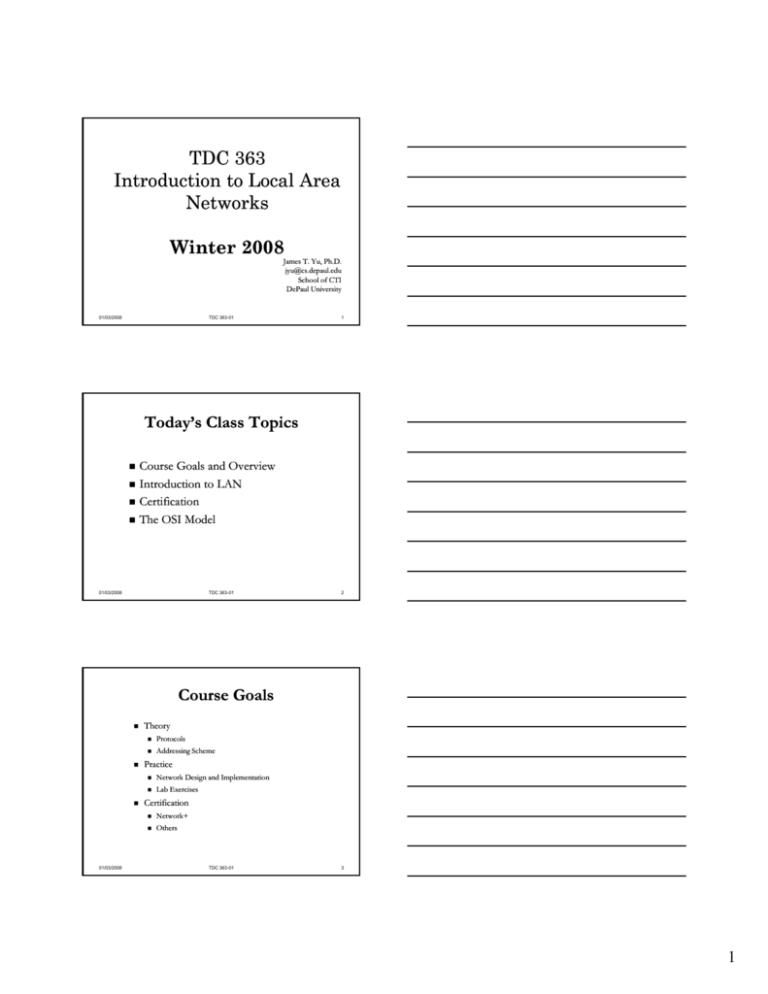
TDC 363 Introduction to Local Area Networks Winter 2008 James T. Yu, Ph.D. jyu@cs.depaul.edu School of CTI DePaul University TDC 363-01 01/03/2008 1 Today’s Class Topics Course Goals and Overview Introduction to LAN Certification The OSI Model TDC 363-01 01/03/2008 2 Course Goals 01/03/2008 Theory Protocols Addressing Scheme Practice Network Design and Implementation Lab Exercises Certification Network+ Others TDC 363-01 3 1 Course Goals (cont.) Understand applications of Local Area Networks (LANs) to achieve business objectives and be able to choose appropriate LAN technologies for particular business applications. Be able to select and interconnect LAN hardware Understand LAN software implementations and design decisions Be able to do basic user and server configuration for Windows 2000 services Novell NetWare services UNIX/Linux services TDC 363-01 01/03/2008 4 Instructor James T. Yu, Ph.D. CTI (CS&T) 476 Phone: (312) 362 362--5938 Office hours: Tu:: 12:30 – 01:15 Tu Th:: 12:30 – 01:15 Th Email: jyu@cs.depaul.edu jyu@cs.depaul.edu Web: http://facweb.cti.depaul.edu/jyu/tdc363/ TDC 363-01 01/03/2008 5 Course Overview (cont.) Class Web Site: http://facweb.cti.depaul.edu/jyu/tdc363 Class Notes (PowerPoint Files) Announcement Assignments and Lab Exercises Class notes are available 24 hours before the class It is your responsibility to download and print a copy of PPT/PDF slides before coming to class. 01/03/2008 TDC 363-01 6 2 Course Overview (cont.) Grade Components: 30% - Homework (3 assignments) 25% - Laboratory Exercises (5 exercises) 20% - Midterm Exam 25% - Final Exam Total = 100 LAN Lab - Room 659 CTI (CS&T) building TDC 363-01 01/03/2008 7 Grading 93 or higher: A 90--92: A90 A85--89: B+ 85 80:84: B 75--79: B75 B- 70-74: C+ 7065--69: C 65 60--64: C60 C50--59: D 50 Below 50: F Class attendance will be used at the instructor’s discretion to adjust the grade. TDC 363-01 01/03/2008 8 Homework and Lab Exercise Homework and lab exercises are submitted via the CourseCourseOn--Line (COL) web site. On Homework is due on the class time ((01:30pm 01:30pm). ). 20% 20 % late penalty for the first day ((01:30pm 01:30pm – 11:59pm) Additional 20% penalty each day after the first day (including weekend) 01/03/2008 Must be a single MS Word file No ZIP files I will waive the penalty for valid reasons supported by signed documents from your doctor or your employer. Discussion with your classmates is encouraged; however, you must not copy each other’s work. The school has a strict policy against plagiarism. TDC 363-01 9 3 Exam Policy No makemake-up exams except for valid reasons supported by signed document from your doctor or your employer. You may take an exam earlier if you have a valid reason. I will not accept personal excuse, such as l i earlier leaving li for f Spring S i break. b k Exam seating is given by the instructor. Exams are closed book, closed notes. Calculator is allowed but no palm computer. You are allowed to bring a 22--page (letter size) note – double size, any font TDC 363-01 01/03/2008 10 Chapter One An Introduction to Networkingg 01/03/2008 TDC 363-01 11 Networks and Standalone Computers Network Collection of computers connected together to share network’s resources: Network ((bandwidth)) (printer, CDCD-ROM, Tape) Software (file, data, application) Hardware/device Standalone computer 01/03/2008 Uses programs and data only from its local disks and is not connected to a network TDC 363-01 12 4 Local Area Network Evolving definitions Characteristics: 01/03/2008 High Communications Speed (1M – 10G) Very Low Error Rate (< 10-8) Limited Geographic Boundaries ( <1km ???) Simple Cabling System (simple encoding scheme) Originally designed to use broadcast transmission to deliver data (that is, each transmitted data packet is delivered to all other devices on LAN). TDC 363-01 13 Why Network? Answer: sharing Sharing g of What? Answer: resources What Resources? 01/03/2008 TDC 363-01 14 Single Cable Network RJ-45 UTP Cross-over cable 01/03/2008 TDC 363-01 15 5 LAN Type: Peer--toPeer to-Peer Network Computers communicate on single segment of cable and share each other’s data and devices Simple example of a local area network (LAN) 01/03/2008 TDC 363-01 16 LAN Type: Client/Server Network 01/03/2008 TDC 363-01 17 Advantages of Server Server--Based over Peer Peer--toto-Peer Networks 01/03/2008 User login accounts and passwords can be assigned in one place. Access to multiple shared resources can be centrally tr ll controlled. tr ll d Servers are optimized to handle heavy processing loads and dedicated to handling requests from clients. Servers can support a large number of computers. TDC 363-01 18 6 MANs and WANs Campus Area Network (CAN) Metropolitan Area Network (MAN) Wide Area Network (WAN) Network that spans large distance and connects two or more LANs The Internet is an example of a very intricate and extensive WAN that spans the globe 01/03/2008 TDC 363-01 19 WAN Connection provided by a Service Provider 01/03/2008 TDC 363-01 20 Public Network Internet Internet Extranet *Intranet ≠ LAN. Intranet Private Network 01/03/2008 TDC 363-01 21 7 Network Elements Workstation Host Client Server Network interface card (NIC) Networkk Operating i System S (NOS) ( S) Node (can be identified with an address) Protocols – communication rules between senders and receivers Data Packets Transmission Media [Topology] TDC 363-01 01/03/2008 22 Network Interface Card (NIC) RJ-45 AUI cf. Figure 1-5: A network t k interface i t f card (NIC) BNC Current NIC type: PCI, USB, or PCMCIA 01/03/2008 Old days: ISA, EISA TDC 363-01 23 How Networks Are Used Services provided by a network File services (file sharing) Print/Printer services (printer sharing) Communications services Mail services Internet services Management services 01/03/2008 TDC 363-01 24 8 Network Certification Network+ Why certification? How? http://www.gocertify.com/certification/ TDC 363-01 01/03/2008 25 Review Questions What are the advantages of network computers vs. standalone computers? What are the characteristics of LAN? List three typical network services. What are the advantages of clientclient-server networking over peerpeer-toto-peer networking? What is the difference between A+ and Network+? 01/03/2008 Give three examples of network services TDC 363-01 26 Chapter 2 Networkingg Standards and the OSI Model 01/03/2008 TDC 363-01 27 9 Standards Standards are documented agreements containing technical specifications or other precise criteria that stipulate how a particular product d or service i should h ld b be ddesigned i d or performed TDC 363-01 01/03/2008 28 Standard Organizations ANSI – American National Standards Institute EIA – Electronic Industries Alliance IEEE – Institute of Electrical and Electronic Engineers Visit the IEEE standard web site Find the document of IEEE 802.3 ISO – International Organization for Standardization ITU – International Telecommunication Union ICANN – Internet Corporation for Assigned Names and Numbers IETF – Internet Engineering Task Force 01/03/2008 Where can you find the standards of Internet Protocol (IP)? TDC 363-01 29 The OSI Model Open Systems Interconnection (OSI) Model 01/03/2008 Model for understanding and developing computercomputer-to to-computer communication Developed p in the 1980s byy ISO Divides network architecture into seven layers TDC 363-01 30 10 The OSI Model (cont.) 01/03/2008 TDC 363-01 31 the OSI Model 01/03/2008 TDC 363-01 32 Fragmentation and Reassembly Fragmentation: Divide a large data frame/packet from the upper layer into smaller pieces and send to the lower layer Reassembly: Assemble smaller pieces from the lower layer into the original frame/packet and send to the upper layer Fragmentation may appear at any layer of the OSI model. 01/03/2008 TDC 363-01 33 11 Flow Control Synchronize the transmission of the sender and receiver. In general, slows down the sender so that the receiver can process data. Flow control between adjacent points Flow control between the end points. Flow control may be applied at any layer in the OSI model. TDC 363-01 01/03/2008 34 Sequencing Sequencing: Process of assigning a placeholder to each piece of a data block to allowing the receiving node reassemble data in correct order. Give Gi a scenario i th thatt th the data d t could ld be b received i d out of sequence. Acknowledgement (ACK) Response generated by the receiver to confirm to the sender that the data was received TDC 363-01 01/03/2008 35 Communications (layer1) Application Presentation Session Application Presentation Session Transport p Transport p Network Network Data Link Data Link Physical Layer-1 Device Layer-1 Device Physical no addressing scheme needed 01/03/2008 TDC 363-01 36 12 Communications (layer2) Application Presentation Session Application Presentation Session Transport p Transport p Network Data Link Physical Network Layer-2 Device Layer-2 Device Data Link Physical layer 2 addressing scheme needed TDC 363-01 01/03/2008 37 Communications (layer3) Application Presentation Session Application Presentation Session Transport p Transport p Network Data Link Network Layer-3 Device Layer-3 Device Physical Data Link Physical layer 2/3 addressing schemes needed 01/03/2008 TDC 363-01 38 IEEE Networking Specifications 01/03/2008 TDC 363-01 39 13 IEEE 802.3 Standard 01/03/2008 10M Ethernet – 802.3 Fast Ethernet – 802.3u Gigabit Ethernet – 802.3z, 802 3z 802.3ab 802 3ab 10 Gigabit Ethernet – 802.3ae, 802.3an TDC 363-01 40 Review Questions Give two examples of standards from IETF Can you find the URL of IEEE 802.11? Give two examples of layer 2 standards specified by IEEE. Wh are the What h standards d d for f 10M Ethernet, Eh 100M Ethernet, 1G Ethernet, and 10G Ethernet? Describe the following terms (as they are used in the OSI model): flow control, segmentation and reassembly, sequence control. 01/03/2008 TDC 363-01 41 Chapter 3 T Transmissions i i andd Networking Media 01/03/2008 TDC 363-01 42 14 Chapter Objectives Explain data transmission concepts and digital signals Describe transmission cables: including coaxial p media cable, STP, UTP, and fiberfiber-optic Describe different Ethernet standards Explain the benefits and limitations of different networking media Identify the practices for cabling buildings and work areas TDC 363-01 01/03/2008 43 Media Guided Media Coax Cable Twisted Pair Unguided Media Fiber Optics Infrared TDC 363-01 01/03/2008 Radio Frequency 44 Media Characteristics 01/03/2008 Throughput Cost Size and scalability Connectors Noise immunity TDC 363-01 45 15 Coaxial Cable Consists of central copper core surrounded by an insulator, braiding, and outer cover called a sheath TDC 363-01 01/03/2008 46 Thicknet (10Base5) Also called thickwire Ethernet Rigid coaxial cable used on original Ethernet networks IEEE EEE designates Thicknet as 10Base5 0Base5 Ethernet Almost never used on new networks but you may find it on older networks Used to connect one data closet to another as part of network backbone TDC 363-01 01/03/2008 47 Thicknet Characteristics Throughput Cost According to IEEE 802.3, Thicknet transmits data at maximum rate of 10 Mbps L expensive Less i than h fiberfiber fib -optic i but b more expensive than some other types of coaxial cable Connector 01/03/2008 Can include a few different types of connectors, which are different from those used on modern networks TDC 363-01 48 16 Thicknet Characteristics In Thicknet networking, the transceiver is a separate device and may also be called a media access unit (MAU) Attachment Unit Interface (AUI) TDC 363-01 01/03/2008 49 Thicknet Characteristics Noise immunity Because of its wide diameter and excellent shielding, it has the highest resistance to noise of any commonlyy used types yp of network wiringg Size and scalability Because of its high noise resistance, it allows data to travel longer than other types of cabling TDC 363-01 01/03/2008 50 Thinnet (10Base2) Also known as thin Ethernet Characteristics: Throughput Cost 01/03/2008 Can transmit at maximum rate of 10 Mbps Less expensive than Thicknet and fiberfiber-optic cable More expensive than twistedtwisted-pair wiring Connectors Connects wire to network devices with BNC TT-connectors A seen in Figure 44-19, BNC barrel connectors are used to join two Thinnet cable segments together TDC 363-01 51 17 Thinnet (10Base2) Characteristics (cont.): Size and scalability Allows a maximum of 185 m per network segment g (see ( Figure g 44-20) Noise immunity More resistant than twisted--pair wiring twisted Less resistant than twisted--pair wiring twisted TDC 363-01 01/03/2008 52 Thinnet (10Base2) Signal bounce Caused by improper termination on a bus network Travels endlesslyy between two ends of network Prevents new signals from getting through TDC 363-01 01/03/2008 53 Twisted--Pair (TP) Cable Twisted Color--coded pairs of Color insulated copper wires twisted around each other and encased in plastic coating Twists in wire help p reduce effects of crosstalk Alien Crosstalk 01/03/2008 Number of twists per meter or foot known as twist ratio When signals from adjacent cables interfere with another cable’s transmission TDC 363-01 54 18 Shielded Twisted Twisted--Pair (STP) STP cable consists of twisted wire pairs that are individually insulated and surrounded by shielding made of metallic substance TDC 363-01 01/03/2008 55 Unshielded TwistedTwisted-Pair Consists of one or more insulated wire pairs encased in a plastic l i sheath h h Does not contain additional shielding TDC 363-01 01/03/2008 56 Unshielded TwistedTwisted-Pair To manage network cabling, it is necessary to be familiar with standards used on modern networks, particularly 01/03/2008 Category 3 (CAT3) Category 5 (CAT5) Category 5e Category 6 (CAT6) TDC 363-01 57 19 UTP Cable Standards Category 01/03/2008 Bandwidth Use 3 16MHz 10Base 10Base--T and voice 4 20MHz Never really used 5 100MHz 100Base 100Base--T and 1000Base1000Base-T 5e 100MHz 100BaseTX, Gigabit Ethernet 6 and 6a 250MHz Gigabit and 10G Ethernet 7 600MHz ??? TDC 363-01 58 10BaseT Popular Ethernet networking standard that replaced 10Base2 and 10Base5 technologies A 10BaseT Ethernet network 01/03/2008 TDC 363-01 59 100BaseT and 1000BaseT Enables LANs to run at 100100-Mbps and 1G bps 100BaseT == Fast Ethernet Two 100BaseT specifications have competed for popularity as organizations move to 100100-Mbps technology: 100BaseTX: Cat Cat--5 Cable, full duplex 100BaseT4: CatCat-3 cable, half duplex 1000BaseT: CatCat-5e cable, full duplex 10GBaseT: CatCat-6 and CatCat-6a 01/03/2008 TDC 363-01 60 20 Comparing STP and UTP Throughput Cost C Connector Noise immunity Size and scalability Both can transmit up to 100 Mbps STP is more expensive Both use RJ RJ--45 connectors (see Figure 44--27) and data jacks STP is more noisenoise-resistant Maximum segment length for both is 100 meters TDC 363-01 01/03/2008 61 RJ--45 Connector RJ TDC 363-01 01/03/2008 62 Different UTP Cables Straight--through cable Straight Crossover cable Terminations at both ends are identical Terminations locations of transmit and receiver wires on one end of cable are reversed 01/03/2008 TDC 363-01 63 21 Fiber--Optic Cable Fiber Contains one or several glass fibers at its core Surrounding the fibers is a layer of glass called cladding A fiber-optic cable TDC 363-01 01/03/2008 64 Fiber--Optic Cable Fiber Single--mode fiber Single Carries light pulses along single path Multimode l d ffiber b Many pulses of light generated by LED travel at different angles TDC 363-01 01/03/2008 65 Fiber--Optic Cable Fiber Two popular connectors used with fiberfiber-optic cable: 01/03/2008 ST connectors SC connectors MT--RJ MT LC TDC 363-01 66 22 Fiber Types Fiber Type Core (microns) Cladding (microns) 62.5/125 62.5 125 50/125 50 125 100/140 100 140 8.3/125 8.3 125 Advantage: noise resistance, less attenuation, and higher bandwidth. Disadvantage: cost, installation/maintenance, and fragility. 01/03/2008 TDC 363-01 67 TDC 363-01 68 Cable Standard for Ethernet 01/03/2008 Cable Design and Management A structured cabling hierarchy 01/03/2008 TDC 363-01 69 23 Cable Design and Management Cable plant Hardware comprising enterprise--wide enterprise cabling system Structured cabling Method for uniform, enterprise--wide, enterprise multivendor cabling systems 01/03/2008 TDC 363-01 70 Cable Design and Management Equipment room Telecommunicatio ns closet Punch-down Punchblock Patch panel is a wall--mounted wall panel of data receptors 01/03/2008 TDC 363-01 71 Cable Design and Management Horizontal wiring 01/03/2008 TDC 363-01 72 24 Cable Design and Management Work area Patch cable is a relatively short section of twisted twisted-pair cablingg with p connectors on both ends that connect network devices to data outlets 01/03/2008 TDC 363-01 73 TDC 363-01 74 Installing Cable 01/03/2008 Review Questions What is attenuation? How do you solve this problem? Comparison of 10Base5, 10Base2, and 10BaseT: speed, distance, cable (Coax cable, STP, UTP, and fiber), connector (AUI, BNC, RJRJ-45). Comparison of UTP and STP. Which one is more popular? Why? Various Ethernet cable standards Data rate, cable (UTP, MM, SM), and network distance Compare crossover cable vs. straight through cable. Provide an example where your will use crossover cable. 01/03/2008 TDC 363-01 75 25 Review Questions (cont.) Comparison of SM and MM. Provide an example where you will use SM and another example where you prefer to use MM. Draw a diagram g to illustrate the entrance facility, equipment room, and telecom room (wiring closet). Draw a diagram to illustrate the use of punch down block and patch panel. What are their functions? Where do you see them? 01/03/2008 TDC 363-01 76 26
